Microstructure and Mechanical Properties of Co-Cr-Mo-Si-Y-Zr High Entropy Alloy
Abstract
:1. Introduction
2. Materials and Methods
3. Results and Discussion
3.1. Phase Analysis
3.2. SEM Microstructure Studies
3.3. TEM Microstructure Analysis
3.4. HT DSC Measurements
3.5. Mechanical Properties
4. Conclusions
Author Contributions
Funding
Acknowledgments
Conflicts of Interest
References
- Cantor, B.; Chang, I.T.H.; Knight, P.; Vincent, A.J.B. Microstructural development in equiatomic multicomponent alloys. Mater. Sci. Eng. A 2004, 375, 213–218. [Google Scholar] [CrossRef]
- Yeh, J.-W. Overview of High-Entropy Alloys. In High-Entropy Alloys: Fundamentals and Applications; Gao, M.C., Yeh, J.-W., Liaw, P.K., Zhang, Y., Eds.; Springer International Publishing: Cham, Switzerland, 2016; pp. 1–19. ISBN 978-3-319-27013-5. [Google Scholar]
- Steurer, W. Single-phase high-entropy alloys—A critical update. Mater. Charact. 2020, 162, 110179. [Google Scholar] [CrossRef]
- Chen, T.K.; Wong, M.S.; Shun, T.T.; Yeh, J.W. Nanostructured nitride films of multi-element high-entropy alloys by reactive DC sputtering. Surf. Coat. Technol. 2005, 200, 1361–1365. [Google Scholar] [CrossRef]
- Hsu, C.-Y.; Yeh, J.-W.; Chen, S.-K.; Shun, T.-T. Wear resistance and high-temperature compression strength of Fcc CuCoNiCrAl0.5Fe alloy with boron addition. Metall. Mater. Trans. A 2004, 35, 1465–1469. [Google Scholar] [CrossRef]
- Huang, P.-K.; Yeh, J.-W.; Shun, T.-T.; Chen, S.-K. Multi-Principal-Element Alloys with Improved Oxidation and Wear Resistance for Thermal Spray Coating. Adv. Eng. Mater. 2004, 6, 74–78. [Google Scholar] [CrossRef]
- Yeh, J.-W.; Lin, S.-J.; Chin, T.-S.; Gan, J.-Y.; Chen, S.-K.; Shun, T.-T.; Tsau, C.-H.; Chou, S.-Y. Formation of simple crystal structures in Cu-Co-Ni-Cr-Al-Fe-Ti-V alloys with multiprincipal metallic elements. Metall. Mater. Trans. A 2004, 35, 2533–2536. [Google Scholar] [CrossRef]
- Yeh, J.-W.; Chen, S.-K.; Lin, S.-J.; Gan, J.-Y.; Chin, T.-S.; Shun, T.-T.; Tsau, C.-H.; Chang, S.-Y. Nanostructured High-Entropy Alloys with Multiple Principal Elements: Novel Alloy Design Concepts and Outcomes. Adv. Eng. Mater. 2004, 6, 299–303. [Google Scholar] [CrossRef]
- Zhang, Y.; Zuo, T.; Cheng, Y.; Liaw, P.K. High-entropy alloys with high saturation magnetization, electrical resistivity, and malleability. Sci. Rep. 2013, 3, 1455. [Google Scholar] [CrossRef] [PubMed] [Green Version]
- Gludovatz, B.; Hohenwarter, A.; Catoor, D.; Chang, E.H.; George, E.P.; Ritchie, R.O. A fracture-resistant high-entropy alloy for cryogenic applications. Science 2014, 345, 1153–1158. [Google Scholar] [CrossRef] [PubMed] [Green Version]
- Lu, Y.; Dong, Y.; Guo, S.; Jiang, L.; Kang, H.; Wang, T.; Wen, B.; Wang, Z.; Jie, J.; Cao, Z.; et al. A promising new class of high-temperature alloys: Eutectic high-entropy alloys. Sci. Rep. 2014, 4, 6200. [Google Scholar] [CrossRef]
- Senkov, O.N.; Wilks, G.B.; Miracle, D.B.; Chuang, C.P.; Liaw, P.K. Refractory high-entropy alloys. Intermetallics 2010, 18, 1758–1765. [Google Scholar] [CrossRef]
- Biesiekierski, A.; Wang, J.; Abdel-Hady Gepreel, M.; Wen, C. A new look at biomedical Ti-based shape memory alloys. Acta Biomater. 2012, 8, 1661–1669. [Google Scholar] [CrossRef] [PubMed]
- Wang, S.P.; Xu, J. TiZrNbTaMo high-entropy alloy designed for orthopedic implants: As-cast microstructure and mechanical properties. Mater. Sci. Eng. C 2017, 73, 80–89. [Google Scholar] [CrossRef] [PubMed]
- Glowka, K.; Zubko, M.; Swiec, P.; Prusik, K.; Dercz, G.; Stróz, D. Microstructure analysis of equiatomic multi-component Ni20Ti20Ta20Co20Cu20 alloy. Arch. Metall. Mater. 2019, 64, 785–789. [Google Scholar] [CrossRef]
- Glowka, K.; Zubko, M.; Swiec, P.; Prusik, K.; Dercz, G.; Matyja, E.; Stróz, D. Microstructure of multi-component Ni35Ti35Ta10Co10Cu10 alloy. Arch. Metall. Mater. 2019, 64, 715–719. [Google Scholar] [CrossRef]
- Chen, C.H.; Chen, Y.J. Shape memory characteristics of (TiZrHf)50Ni25Co10Cu15 high entropy shape memory alloy. Scr. Mater. 2019, 162, 185–189. [Google Scholar] [CrossRef]
- MacDonald, B.E.; Fu, Z.; Zheng, B.; Chen, W.; Lin, Y.; Chen, F.; Zhang, L.; Ivanisenko, J.; Zhou, Y.; Hahn, H.; et al. Recent Progress in High Entropy Alloy Research. JOM 2017, 69, 2024–2031. [Google Scholar] [CrossRef]
- Miracle, D.B.; Senkov, O.N. A critical review of high entropy alloys and related concepts. Acta Mater. 2017, 122, 448–511. [Google Scholar] [CrossRef] [Green Version]
- Takeuchi, A.; Amiya, K.; Wada, T.; Yubuta, K.; Zhang, W.; Makino, A. Entropies in Alloy Design for High-Entropy and Bulk Glassy Alloys. Entropy 2013, 15, 3810–3821. [Google Scholar] [CrossRef]
- Xing, Q.W.; Zhang, Y. Amorphous phase formation rules in high-entropy alloys. Chin. Phys. B 2017, 26, 18104. [Google Scholar] [CrossRef]
- Yang, Y.; Ye, Y.F.; Liu, C.T.; Lu, J.; Wang, Q. High-entropy alloy: Challenges and prospects. Mater. Today 2015, 19, 349–362. [Google Scholar] [CrossRef]
- Nong, Z.-S.; Zhu, J.-C.; Cao, Y.; Yang, X.-W.; Lai, Z.-H.; Liu, Y. Stability and structure prediction of cubic phase in as cast high entropy alloys. Mater. Sci. Technol. 2014, 30, 363–369. [Google Scholar] [CrossRef]
- Pitzer, K.S. The Nature of the Chemical Bond and the Structure of Molecules and Crystals: An Introduction to Modern Structural Chemistry. J. Am. Chem. Soc. 1960, 82, 4121. [Google Scholar] [CrossRef]
- Dong, Y.; Lu, Y.; Jiang, L.; Wang, T.; Li, T. Effects of electro-negativity on the stability of topologically close-packed phase in high entropy alloys. Intermetallics 2014, 52, 105–109. [Google Scholar] [CrossRef]
- Yang, X.; Zhang, Y. Prediction of high-entropy stabilized solid-solution in multi-component alloys. Mater. Chem. Phys. 2012, 132, 233–238. [Google Scholar] [CrossRef]
- Ye, Y.F.; Wang, Q.; Lu, J.; Liu, C.T.; Yang, Y. The generalized thermodynamic rule for phase selection in multicomponent alloys. Intermetallics 2015, 59, 75–80. [Google Scholar] [CrossRef]
- Wang, Z.; Huang, Y.; Yang, Y.; Wang, J.; Liu, C.T. Atomic-size effect and solid solubility of multicomponent alloys. Scr. Mater. 2015, 94, 28–31. [Google Scholar] [CrossRef]
- Inoue, A. Stabilization of metallic supercooled liquid and bulk amorphous alloys. Acta Mater. 2000, 48, 279–306. [Google Scholar] [CrossRef]
- Lu, Z.P.; Liu, C.T. Role of minor alloying additions in formation of bulk metallic glasses: A review. J. Mater. Sci. 2004, 39, 3965–3974. [Google Scholar] [CrossRef]
- Choi-Yim, H.; Busch, R.; Johnson, W.L. The effect of silicon on the glass forming ability of the Cu47Ti34Zr11Ni8 bulk metallic glass forming alloy during processing of composites. J. Appl. Phys. 1998, 83, 7993–7997. [Google Scholar] [CrossRef]
- Yi, S.; Park, T.G.; Kim, D.H. Ni-based bulk amorphous alloys in the Ni-Ti-Zr-(Si,Sn) system. J. Mater. Res. 2000, 15, 2425–2430. [Google Scholar] [CrossRef]
- Inoue, A.; Murakami, A.; Zhang, T.; Takeuchi, A. Thermal stability and magnetic properties of bulk amorphous Fe-Al-Ga-P-C-B-Si alloys. Mater. Trans. JIM 1997, 38, 189–196. [Google Scholar] [CrossRef] [Green Version]
- Yazici, Z.O.; Hitit, A.; Yalcin, Y.; Ozgul, M. Effects of minor Cu and Si additions on glass forming ability and mechanical properties of Co-Fe-Ta-B Bulk metallic glass. Met. Mater. Int. 2016, 22, 50–57. [Google Scholar] [CrossRef]
- Zhang, T.; Kurosaka, K.; Inoue, A. Thermal and mechanical properties of Cu-based Cu-Zr-Ti-Y bulk glassy alloys. Mater. Trans. 2001, 42, 2042–2045. [Google Scholar] [CrossRef]
- Lu, Z.P.; Liu, C.T.; Porter, W.D. Role of yttrium in glass formation of Fe-based bulk metallic glasses. Appl. Phys. Lett. 2003, 83, 2581–2583. [Google Scholar] [CrossRef]
- Lu, Z.P.; Liu, C.T.; Carmichael, C.A.; Porter, W.D.; Deevi, S.C. Bulk glass formation in an Fe-Based Fe-Y-Zr-M (M = Cr, Co, Al)-Mo-B system. J. Mater. Res. 2004, 19, 921–929. [Google Scholar] [CrossRef]
- Park, J.M.; Park, J.S.; Na, J.H.; Kim, D.H.; Kim, D.H. Effect of Y addition on thermal stability and the glass forming ability in Fe-Nb-B-Si bulk glassy alloy. Mater. Sci. Eng. A 2006, 435–436, 425–428. [Google Scholar] [CrossRef]
- Figueroa, I.A.; Davies, H.A.; Todd, I. High glass formability for Cu-Hf-Ti alloys with small additions of y and Si. Philos. Mag. 2009, 89, 2355–2368. [Google Scholar] [CrossRef]
- Guo, S.; Liu, C.T. Phase stability in high entropy alloys: Formation of solid-solution phase or amorphous phase. Prog. Nat. Sci. Mater. Int. 2011, 21, 433–446. [Google Scholar] [CrossRef] [Green Version]
- Skriver, H.L. Crystal structure from one-electron theory. Phys. Rev. B 1985, 31, 1909–1923. [Google Scholar] [CrossRef]
- Wang, W.H. Roles of minor additions in formation and properties of bulk metallic glasses. Prog. Mater. Sci. 2007, 52, 540–596. [Google Scholar] [CrossRef]
- Tong, Y.; Qiao, J.C.; Zhang, C.; Pelletier, J.M.; Yao, Y. Mechanical properties of Ti16.7Zr16.7Hf16.7Cu16.7Ni16.7Be16.7 high-entropy bulk metallic glass. J. Non-Cryst. Solids 2016, 452, 57–61. [Google Scholar] [CrossRef]
- Takeuchi, A.; Chen, N.; Wada, T.; Yokoyama, Y.; Kato, H.; Inoue, A.; Yeh, J.W. Pd20Pt20Cu20Ni20P20 high-entropy alloy as a bulk metallic glass in the centimeter. Intermetallics 2011, 19, 1546–1554. [Google Scholar] [CrossRef]
- Swiec, P.; Zubko, M.; Stróz, D.; Lekston, Z. Analysis of amorphous regions in severely marformed NiTi shape memory alloy. Int. J. Mater. Res. 2019, 110, 18–23. [Google Scholar] [CrossRef]
- Lai, C.H.; Chen, W.C.; Tsai, P.H.; Ding, I.P. Effects of alloying additions in the CrMo underlayer on the grain size and magnetic properties of CoCrPt longitudinal media. J. Appl. Phys. 2003, 93, 8468–8470. [Google Scholar] [CrossRef]
- Liu, R.; Yao, J.; Zhang, Q.; Yao, M.X.; Collier, R. Effects of Silicon Content on the Microstructure and Mechanical Properties of Cobalt-Based Tribaloy Alloys. J. Eng. Mater. Technol. Trans. ASME 2016, 138, 2–8. [Google Scholar] [CrossRef]
- Yao, M.X.; Wu, J.B.C.; Liu, R. Microstructural characteristics and corrosion resistance in molten Zn-Al bath of Co-Mo-Cr-Si alloys. Mater. Sci. Eng. A 2005, 407, 299–305. [Google Scholar] [CrossRef]
- Liao, W.; Lan, S.; Gao, L.; Zhang, H.; Xu, S.; Song, J.; Wang, X.; Lu, Y. Nanocrystalline high-entropy alloy (CoCrFeNiAl0.3) thin-film coating by magnetron sputtering. Thin Solid Films 2017, 638, 383–388. [Google Scholar] [CrossRef]
- Sun, Y.; Chen, P.; Liu, L.; Yan, M.; Wu, X.; Yu, C.; Liu, Z. Local mechanical properties of AlxCoCrCuFeNi high entropy alloy characterized using nanoindentation. Intermetallics 2018, 93, 85–88. [Google Scholar] [CrossRef]
- Zhang, L.J.; Zhang, M.D.; Zhou, Z.; Fan, J.T.; Cui, P.; Yu, P.F.; Jing, Q.; Ma, M.Z.; Liaw, P.K.; Li, G.; et al. Effects of rare-earth element, Y, additions on the microstructure and mechanical properties of CoCrFeNi high entropy alloy. Mater. Sci. Eng. A 2018, 725, 437–446. [Google Scholar] [CrossRef] [Green Version]
- Ma, Y.; Feng, Y.H.; Debela, T.T.; Peng, G.J.; Zhang, T.H. Nanoindentation study on the creep characteristics of high-entropy alloy films: Fcc versus bcc structures. Int. J. Refract. Met. Hard Mater. 2016, 54, 395–400. [Google Scholar] [CrossRef]
- Ganji, R.S.; Karthik, P.S.; Rao, K.B.S.; Rajulapati, K.V. Strengthening mechanisms in equiatomic ultrafine grained AlCoCrCuFeNi high-entropy alloy studied by micro- and nanoindentation methods. Acta Mater. 2017, 125, 58–68. [Google Scholar] [CrossRef]
- Maier-Kiener, V.; Schuh, B.; George, E.P.; Clemens, H.; Hohenwarter, A. Nanoindentation testing as a powerful screening tool for assessing phase stability of nanocrystalline high-entropy alloys. Mater. Des. 2017, 115, 479–485. [Google Scholar] [CrossRef] [Green Version]
- Sinha, S.; Mirshams, R.A.; Wang, T.; Nene, S.S.; Frank, M.; Liu, K.; Mishra, R.S. Nanoindentation behavior of high entropy alloys with transformation-induced plasticity. Sci. Rep. 2019, 9, 6639. [Google Scholar] [CrossRef]
- Sinha, S.; Nene, S.S.; Frank, M.; Liu, K.; Mishra, R.S.; McWilliams, B.A.; Cho, K.C. Revealing the microstructural evolution in a high entropy alloy enabled with transformation, twinning and precipitation. Materialia 2019, 6, 100310. [Google Scholar] [CrossRef]
- Nene, S.S.; Sinha, S.; Frank, M.; Liu, K.; Mishra, R.S.; McWilliams, B.A.; Cho, K.C. Unexpected strength–ductility response in an annealed, metastable, high-entropy alloy. Appl. Mater. Today 2018, 13, 198–206. [Google Scholar] [CrossRef]
- Nene, S.S.; Frank, M.; Liu, K.; Sinha, S.; Mishra, R.S.; McWilliams, B.; Cho, K.C. Reversed strength-ductility relationship in microstructurally flexible high entropy alloy. Scr. Mater. 2018, 154, 163–167. [Google Scholar] [CrossRef]
- Jiao, Z.M.; Chu, M.Y.; Yang, H.J.; Wang, Z.H.; Qiao, J.W. Nanoindentation characterised plastic deformation of a Al0.5CoCrFeNi high entropy alloy. Mater. Sci. Technol. 2015, 31, 1244–1249. [Google Scholar] [CrossRef]
- Sun, Y.; Zhao, G.; Wen, X.; Qiao, J.; Yang, F. Nanoindentation deformation of a bi-phase AlCrCuFeNi2 alloy. J. Alloys Compd. 2014, 608, 49–53. [Google Scholar] [CrossRef]
- Coury, F.G.; Wilson, P.; Clarke, K.D.; Kaufman, M.J.; Clarke, A.J. High-throughput solid solution strengthening characterization in high entropy alloys. Acta Mater. 2019, 167, 1–11. [Google Scholar] [CrossRef]
- Wu, D.; Jang, J.S.C.; Nieh, T.G. Elastic and plastic deformations in a high entropy alloy investigated using a nanoindentation method. Intermetallics 2016, 68, 118–127. [Google Scholar] [CrossRef] [Green Version]
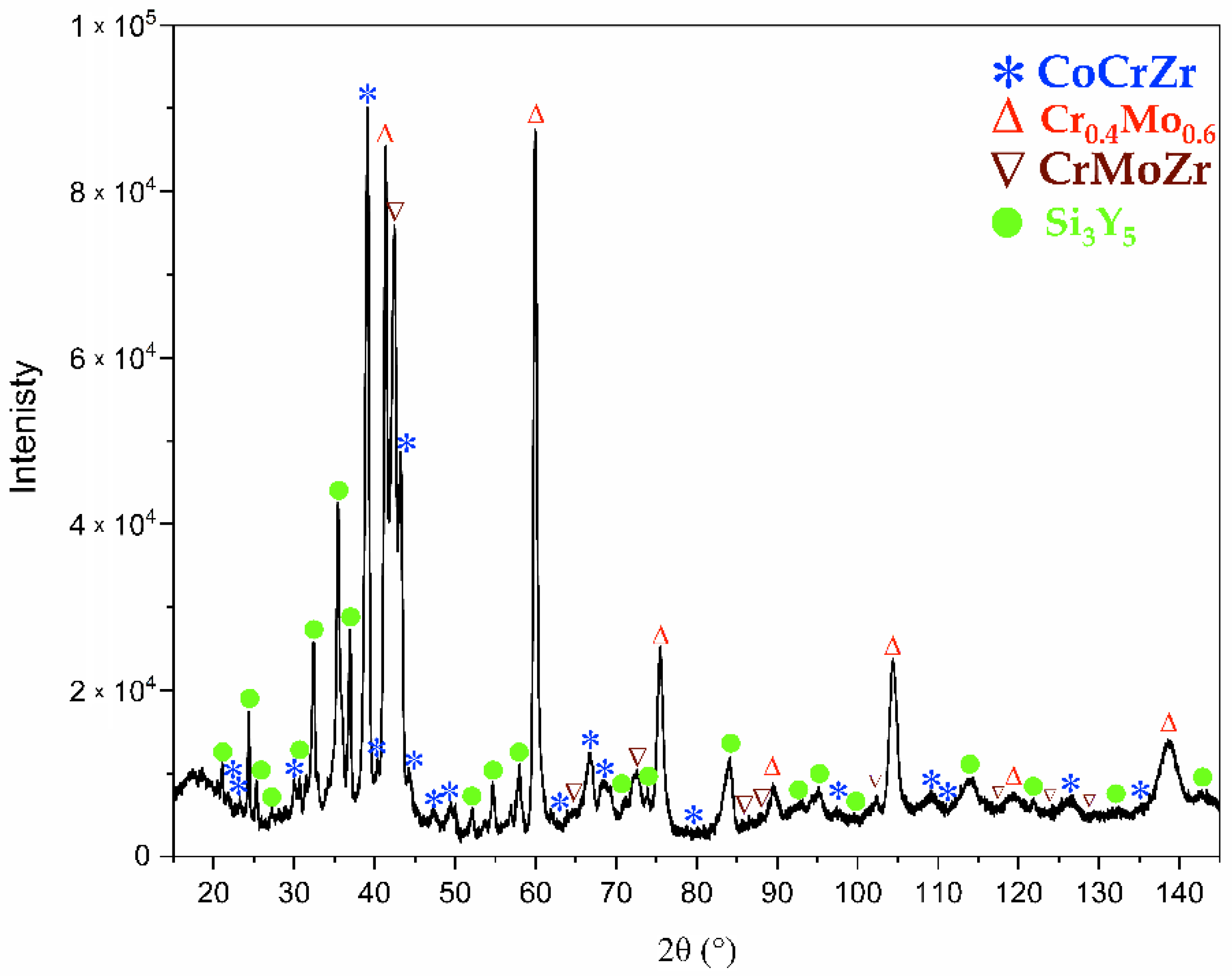
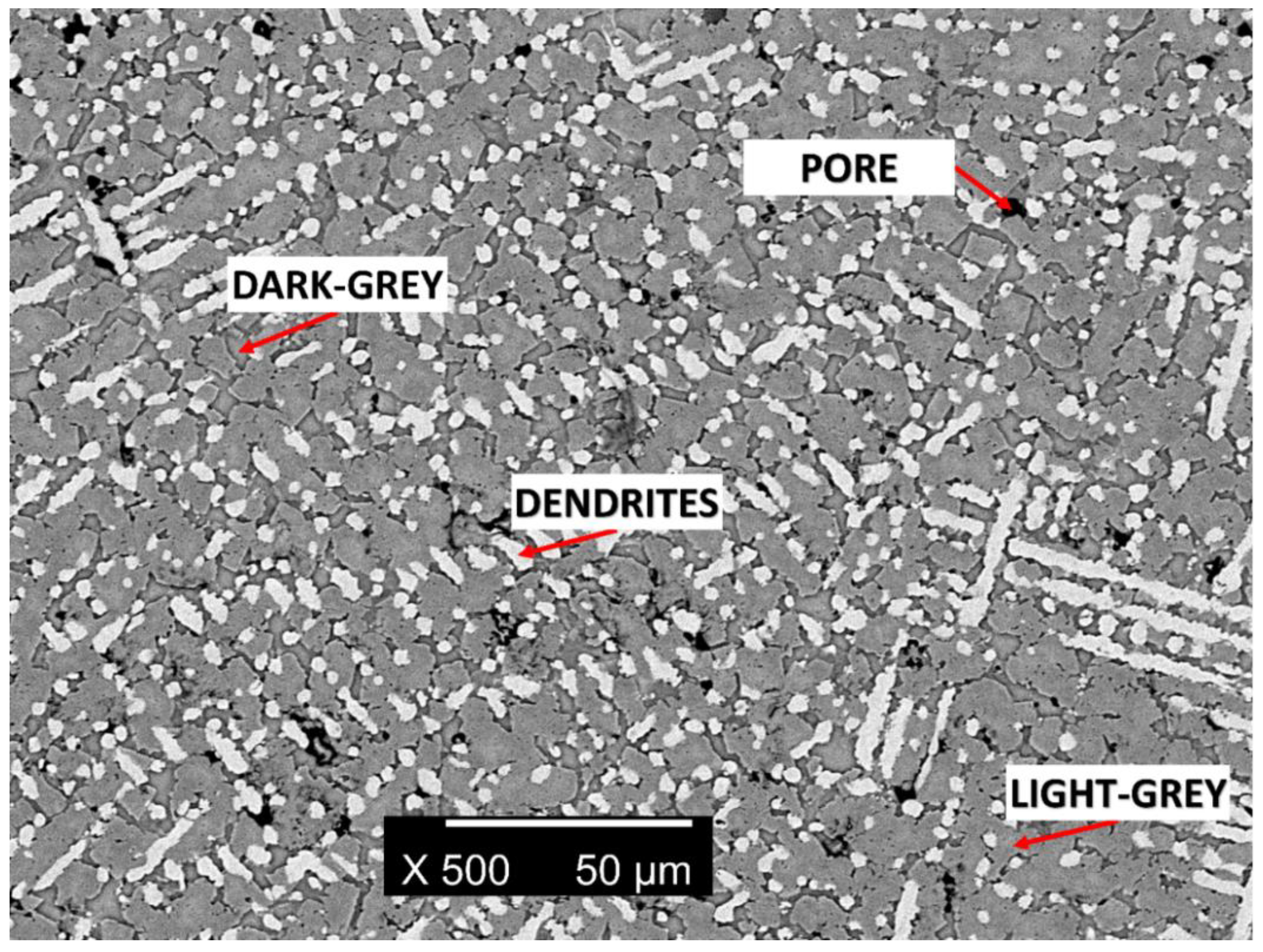
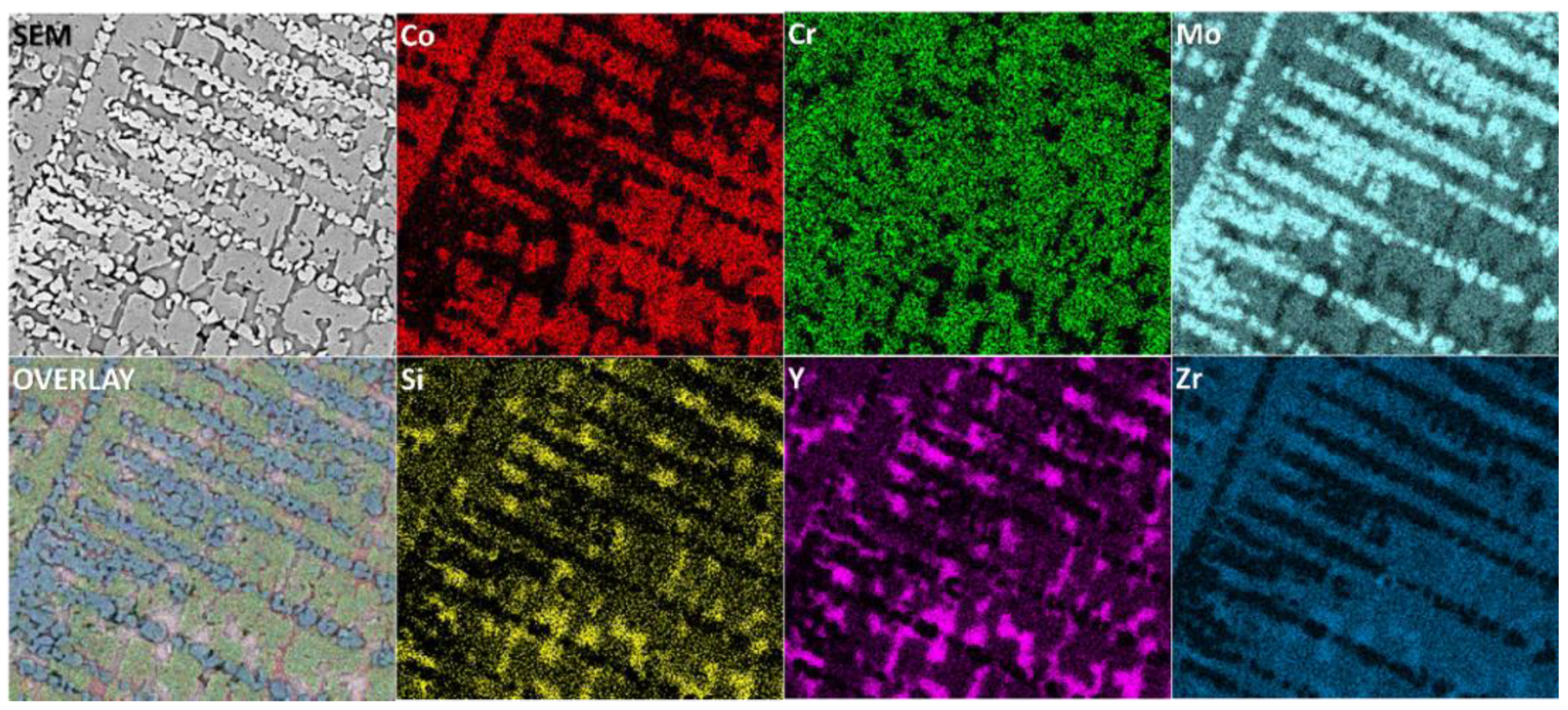
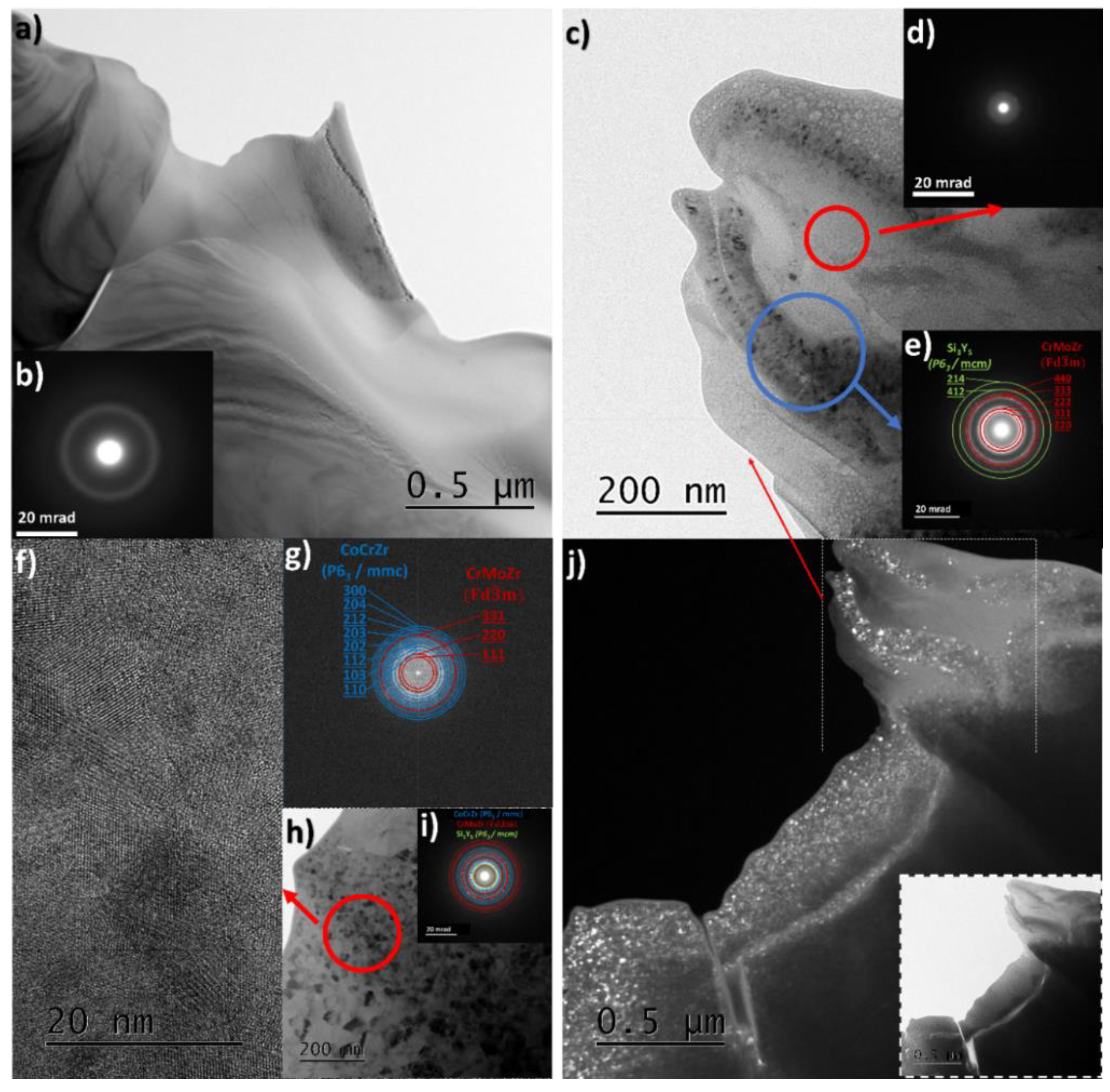

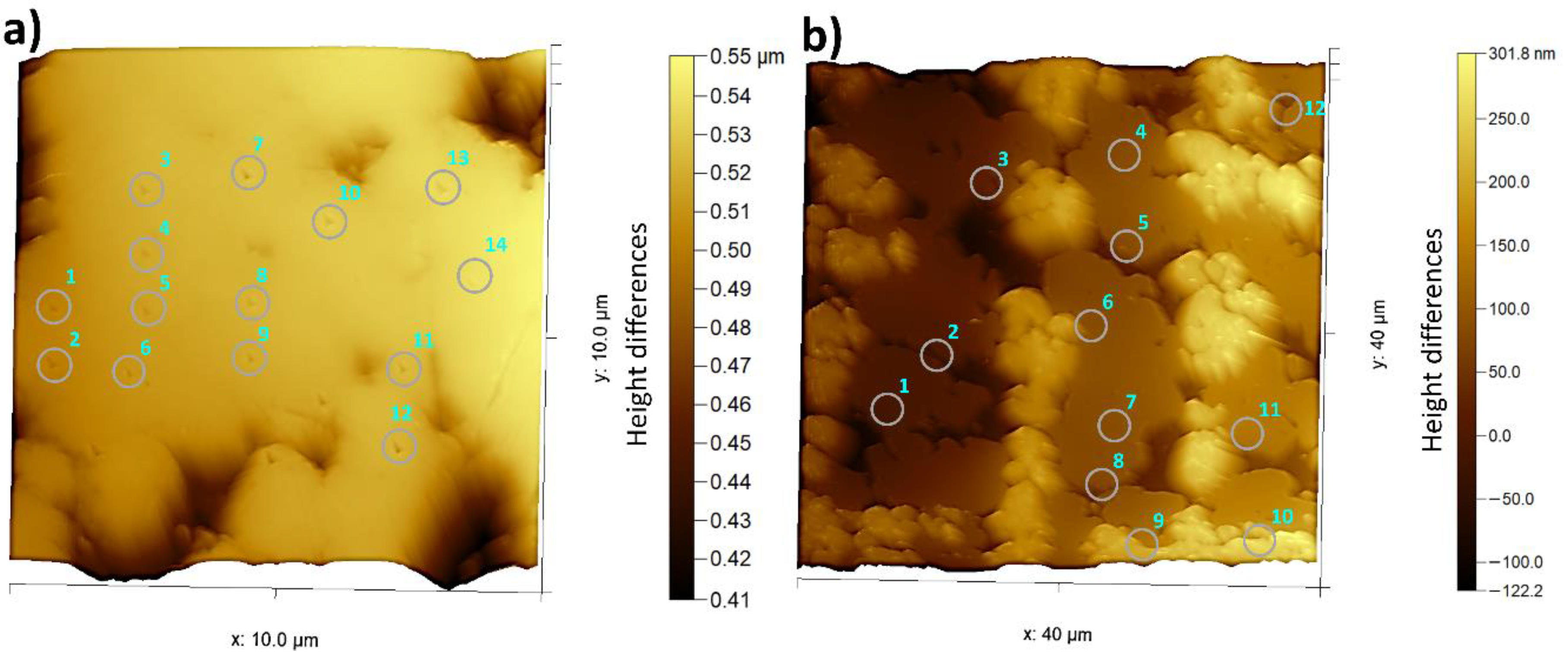
| Element | Crystal Structure | ri (Å) | (VEC)i | (Tm)I (K) | χi (Pauling Units) |
|---|---|---|---|---|---|
| Co | HCP | 1.251 | 9 | 1768 | 1.88 |
| Cr | BCC | 1.249 | 6 | 2180 | 1.66 |
| Mo | BCC | 1.363 | 6 | 2896 | 2.16 |
| Si | FCC | 1.153 | 4 | 1687 | 1.90 |
| Y | HCP | 1.802 | 3 | 1798 | 1.22 |
| Zr | HCP | 1.603 | 4 | 2123 | 1.33 |
| δ (%) | ΔHmix (kJ∙mol−1) | ΔSmix (J(mol·K)−1) | Δχ (eV) | VEC | Ω [26] | Φ [27] | γ [28] | |
|---|---|---|---|---|---|---|---|---|
| ξ = 0.68 | ξ = 0.74 | |||||||
| 15.44 | −29.49 | 14.71 (1.769∙R) | 0.34 | 5.40 | 1.08 | 2.80 | 1.73 | 1.626 |
| Studied Area | Co | Cr | Mo | Si | Y | Zr |
|---|---|---|---|---|---|---|
| Dendrites | 2.4(7) | 29.3(7) | 66.7(8) | 0.9(4) | 0.4(1) | 0.3(8) |
| Light-grey phase | 22.6(6) | 24.5(8) | 14.4(8) | 12.0(3) | 3.3(3) | 23.2(7) |
| Dark-grey phase | 1.6(7) | 1.8(7) | 1.9(7) | 33.2(8) | 59.7(6) | 1.8(9) |
| Studied Area | Co | Cr | Mo | Si | Y | Zr |
|---|---|---|---|---|---|---|
| Amorphous | 30.0(2) | 17.4(2) | 15.9(2) | 4.5(2) | 7.8(2) | 24.4(2) |
| Mixture | 20.6(2) | 16.8(2) | 10.7(1) | 16.5(1) | 18.8(1) | 16.6(1) |
| Nanocrystalline | 30.3(2) | 17.3(2) | 19.2(2) | 3.6(2) | 5.7(2) | 23.9(1) |
| Chemical Composition | Nanohardness H (GPa) | Reduced Young’s Modulus Er (GPa) | Reference |
|---|---|---|---|
| Co15Cr15Mo25Si15Y15Zr15 Light-grey | 17.88 | 193.81 | present study |
| Co15Cr15Mo25Si15Y15Zr15 Dendrites | 13.26 | 184.51 | present study |
| Co60.4Cr8.5Mo28.5Si2.6 Laves phase | 21.81 | 397.50 | [47] |
| Co60.4Cr8.5Mo28.5Si2.6 | 21.80 | 398.00 | [48] |
| Co60.4Cr8.5Mo28.5Si2.6 Solid solution | 13.78 | 310.52 | [47] |
| CoCrFeNiAl0.3 | 12.28 | 197.44 | [49] |
| Co59.8Cr17Mo22Si1.2 Laves phase | 11.38 | 270.48 | [47] |
| Al3CoCrCuFeNi | 10.50 | 260.00 | [50] |
| CoCrFeNiY0.3 Hexagonal phase | 10.50 | 215.00 | [51] |
| CoCrFeNiCuAl2.5 | 9.20 | 174.30 | [52] |
| AlCoCrCuFeNi | 8.13 | 172.00 | [53] |
| CrMnFeCoNi | 7.64 | 252.00 | [54] |
| Co59.8Cr17Mo22Si1.2 Solid solution | 7.48 | 274.03 | [47] |
| CoCrFeNiCu | 7.30 | 188.50 | [52] |
| Fe38.5Mn20Co20Cr15Si5Cu1.5 | 6.83 | 192.60 | [55,56] |
| Fe39Mn20Co20Cr15Si5Al1 | 6.38 | 205.70 | [55,57] |
| Fe40Mn20Co20Cr15Si5 | 5.33 | 156.00 | [55,58] |
| Al0.5CoCrFeNi | 4.64 | 220.84 | [59] |
| AlCrCuFeNi2 (BCC) | 4.60 | 146.00 | [60] |
| CrMnFeCoNi | 4.44 | 205.00 | [61] |
| CoCrFeNiY0.3 FCC phase | 3.30 | 190.00 | [51] |
| CoCrFeNiY0 FCC phase | 2.90 | 185.00 | [51] |
| AlCrCuFeNi2 (FCC) | 2.80 | 207.00 | [60] |
| NiFeCoCrMn | 1.88 | 190.21 | [62] |
Publisher’s Note: MDPI stays neutral with regard to jurisdictional claims in published maps and institutional affiliations. |
© 2020 by the authors. Licensee MDPI, Basel, Switzerland. This article is an open access article distributed under the terms and conditions of the Creative Commons Attribution (CC BY) license (http://creativecommons.org/licenses/by/4.0/).
Share and Cite
Glowka, K.; Zubko, M.; Świec, P.; Prusik, K.; Albrecht, R.; Dercz, G.; Loskot, J.; Witala, B.; Stróż, D. Microstructure and Mechanical Properties of Co-Cr-Mo-Si-Y-Zr High Entropy Alloy. Metals 2020, 10, 1456. https://doi.org/10.3390/met10111456
Glowka K, Zubko M, Świec P, Prusik K, Albrecht R, Dercz G, Loskot J, Witala B, Stróż D. Microstructure and Mechanical Properties of Co-Cr-Mo-Si-Y-Zr High Entropy Alloy. Metals. 2020; 10(11):1456. https://doi.org/10.3390/met10111456
Chicago/Turabian StyleGlowka, Karsten, Maciej Zubko, Paweł Świec, Krystian Prusik, Robert Albrecht, Grzegorz Dercz, Jan Loskot, Bartosz Witala, and Danuta Stróż. 2020. "Microstructure and Mechanical Properties of Co-Cr-Mo-Si-Y-Zr High Entropy Alloy" Metals 10, no. 11: 1456. https://doi.org/10.3390/met10111456





